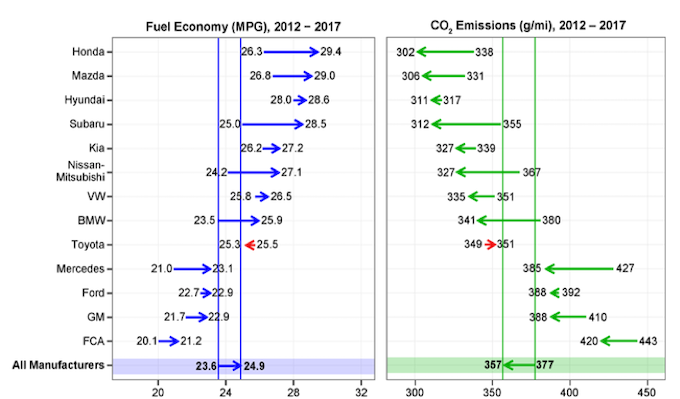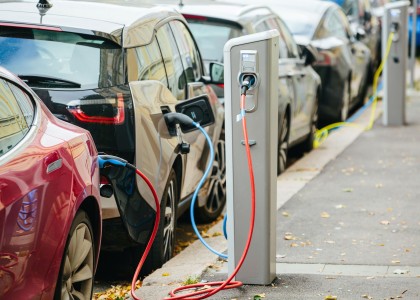Toyota, an industry leader in hybrid technology for two decades, is the only major automaker to lose ground on fuel economy in recent years. And with the Trump administration poised to roll back fuel efficiency standards, Toyota may face less pressure to pick up its pace.
Toyota previously posted one of the industry’s best miles per gallon (mpg) averages for its fleet. It benefitted from selling more than 10 million hybrids worldwide since launching its signature Prius in 1997. Today’s most fuel-efficient Prius gets a whopping 56 mpg.
Still, with robust truck sales, Toyota’s fleet mpg actually decreased from 2012-2017, according to the US Protection Agency’s (EPA) new Automotive Trends Report. In contrast, prodded by stricter US fuel economy standards for 2012-2016 vehicles, the other 12 foreign and domestic manufacturers increased their fleet mpg averages during the same five-year period.
The result: Cuts in carbon dioxide emissions that contribute to climate change and the resulting harm to human health.
Manufacturer-estimated real-world CO2 emissions and fuel economy in model years 2012 and 2017. The two bars show average changes in fuel economy and CO2 emissions for all manufacturers during that time. (From 2018 Automotive Trends Report)
The administration’s proposal to roll back Corporate Average Fuel Economy (CAFE) standards could slow the industry’s overall progress and allow Toyota’s technological foot-dragging to continue. The administration is expected to announce a final rule as early as May.
The EPA report says Toyota lags behind other manufacturers in adopting fuel efficiency technologies such as direct injection, turbocharging, and cylinder deactivation.
Toyota’s Tundra, its only full-size pickup, is emblematic of the company’s failure to keep pace. Since 2011, Tundra has gained no efficiency technologies. As a result, its 8-cylinder four-wheel drive model has remained a fuel-thirsty 18.7 mpg, even as this vehicle’s CAFE target rose to 25.1 mpg for model year 2017.
The Tundra also lags behind Detroit Three pickups—Dodge Ram, Ford F-150, and Chevy Silverado. The all-new 5.7L Dodge Ram pickup has improved its fuel economy by 4 mpg by incorporating mild hybrid technology and 2 mpg by using cutting-edge technologies like active aerodynamics. Ford has improved the F-150’s fuel economy, on average, by 2 mpg by reducing curb weight by 700 pounds, which customers have welcomed.
One of Toyota’s best options may be to embrace hybridization for the Tundra, as it did for passenger cars at the beginning of the new millennium. A full hybrid system could improve the 5.7L V8 Tundra’s fuel economy to more than 25 mpg in real-world driving. This would surpass the Tundra’s 2025 fuel economy target without compromising drivability, horsepower, or torque and may allow Toyota to add new features valued by pickup buyers, like electrical outlets that could power a contractor’s power tools on the job site.
A hybrid Tundra would also allow Toyota to bypass a host of other powertrain improvements, potentially avoiding some costs and complexity of adding multiple technologies. Combining a relatively simple hybrid powertrain with modern vehicle design could help satisfy the Tundra’s customer base while meeting fuel economy requirements for years to come.
Yet if the Trump administration succeeds in rolling back fuel economy standards, Toyota and other manufacturers will have fewer incentives to push for higher-mpg fleets. Consumers will pay the price, refilling their cars more often and breathing dirtier air.




